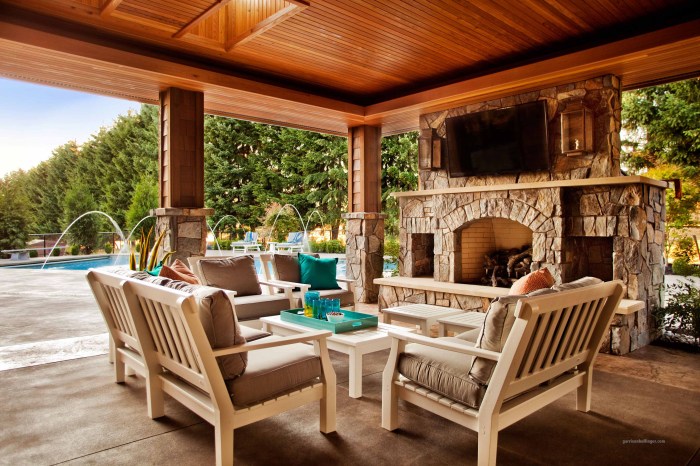Covered Patio Ideas for Backyard: Transform Your Outdoor Space with Style

Covered patio ideas for backyard sets the stage for this enthralling narrative, offering readers a glimpse into a story that is rich in detail and brimming with originality from the outset. From exploring different types of covered patios to discussing design elements and installation options, this guide is your go-to resource for creating a stunning outdoor retreat right in your backyard.
In this guide, we will delve into the world of covered patio designs, materials, and essential design elements, providing you with the inspiration and information needed to elevate your outdoor living space to new heights.
Types of Covered Patios
When it comes to covered patio designs for your backyard, there are several options to choose from. Each type has its own unique features, benefits, and drawbacks that cater to different needs and preferences.
Pergola
A pergola is a versatile and stylish option for a covered patio. It typically consists of vertical posts supporting cross-beams and an open lattice roof. Pergolas offer partial shade and can be adorned with vines or fabric for added privacy.
While they provide a charming aesthetic appeal, pergolas may not offer full protection from the elements like rain or intense sunlight.
Awning
An awning is a retractable or fixed cover that extends from the exterior wall of a house or structure. Awning designs vary from simple fabric canopies to more durable metal or polycarbonate materials. Awning patio covers are great for adjustable shade and can protect against light rain.
However, they may require maintenance and are more susceptible to wear and tear over time.
Gazebo
A gazebo is a freestanding structure with a solid roof and open sides, often with built-in seating or flooring. Gazebos provide full coverage and create a cozy outdoor living space. They are perfect for entertaining guests or enjoying a peaceful retreat in your backyard.
The drawback of a gazebo is its higher cost compared to other patio cover options.
Solid Roof Patio Cover
A solid roof patio cover, such as a metal or shingled roof, offers complete protection from the elements. It provides insulation, durability, and a seamless extension of your home's architecture. Solid roof covers are long-lasting and require minimal maintenance. However, they can be more expensive to install and may block natural light if not designed with skylights or windows.
Materials for Covered Patios

When it comes to constructing a covered patio for your backyard, choosing the right materials is crucial for both durability and aesthetics. Let's explore the various materials commonly used for this purpose and delve into the pros and cons associated with each option.
Wood
Wood is a classic choice for patio covers, offering a natural and warm look to your outdoor space. However, it requires regular maintenance, such as staining or painting, to prevent rotting and warping. While wood can be cost-effective initially, the maintenance costs over time should be taken into consideration.
Aluminum
Aluminum is a lightweight and durable material that requires minimal maintenance. It is resistant to rust and corrosion, making it a popular choice for many homeowners. However, aluminum patio covers may not offer as much insulation as other materials, and they can be prone to denting.
Steel
Steel is a strong and long-lasting material suitable for larger patio structures. It provides excellent protection from the elements and can withstand heavy loads. On the downside, steel patio covers can be more expensive than other options, and they may require periodic repainting to prevent rust.
Polycarbonate
Polycarbonate patio covers are lightweight, shatterproof, and provide good UV protection. They allow natural light to filter through while blocking harmful UV rays. However, they may not offer as much insulation as other materials, and they can be prone to scratching.Consider the maintenance requirements, costs, and aesthetic preferences when choosing the material for your covered patio.
Each option has its own set of advantages and drawbacks, so weigh your priorities carefully before making a decision.
Design Elements
When planning a covered patio for your backyard, there are several key design elements to consider in order to create a functional and aesthetically pleasing outdoor space. Factors such as layout, lighting, flooring, and furniture selection play crucial roles in the overall design.
Layout
- Consider the size and shape of your backyard when determining the layout of your covered patio.
- Ensure there is enough space for seating, dining, and other activities you plan to enjoy in the patio area.
- Create designated zones within the patio for different purposes, such as lounging, cooking, or gardening.
Lighting
- Choose lighting fixtures that will provide both functional and ambient lighting for evening and nighttime use.
- Consider incorporating string lights, lanterns, or sconces to create a cozy and inviting atmosphere.
- Opt for energy-efficient LED lights to save on electricity costs and reduce environmental impact.
Flooring
- Select durable and weather-resistant flooring materials that can withstand outdoor elements.
Furniture Selection
DIY vs. Professional Installation
When it comes to installing a covered patio in your backyard, you have the option of doing it yourself or hiring professionals. Each approach has its own set of advantages and disadvantages, as well as cost considerations.
DIY Installation of a Covered Patio
If you choose to go the DIY route for installing a covered patio in your backyard, here are the general steps involved:
- Start by planning the layout and design of your patio cover.
- Prepare the necessary materials and tools for construction.
- Build the frame and install the roofing materials.
- Add any finishing touches such as lighting or decorations.
Advantages and Disadvantages of Hiring Professionals
- Advantages:
- Professional expertise and experience ensure a high-quality installation.
- Saves time and effort on your part.
- May come with warranties or guarantees on the work done.
- Disadvantages:
- Higher cost compared to a DIY approach.
- You may have less control over the design and materials used.
- Dependent on the availability and schedule of the professionals.
Cost Comparison: DIY vs. Professional Installation
When it comes to cost, DIY installation of a covered patio is generally cheaper as you are only paying for materials and any tools you need. However, the quality of the installation may vary based on your skills and experience.
On the other hand, hiring professionals for patio cover installation can be more expensive upfront, but you are paying for their expertise and ensuring a higher-quality result.
Ultimate Conclusion
As we conclude our exploration of covered patio ideas for backyard, it's clear that with the right design elements, materials, and installation approach, you can transform your outdoor space into a cozy oasis that reflects your style and personality. Whether you choose a DIY approach or seek professional help, the key is to create a space that invites relaxation and enjoyment for years to come.
FAQs
What are the main differences between a pergola and a gazebo?
A pergola typically has an open roof with slatted beams, while a gazebo has a closed roof and is often octagonal or hexagonal in shape.
Is polycarbonate a durable material for a backyard patio cover?
Yes, polycarbonate is known for its durability, lightweight nature, and UV protection, making it a popular choice for patio covers.
How can I choose the right lighting for my covered patio?
Consider ambient, task, and accent lighting to create a balanced and inviting atmosphere in your outdoor space.




